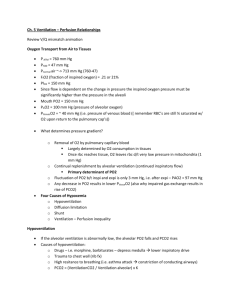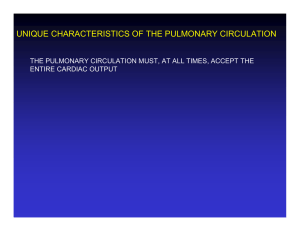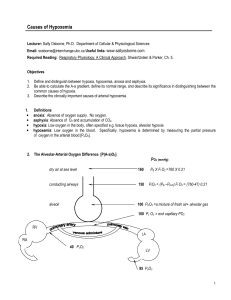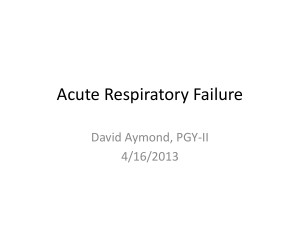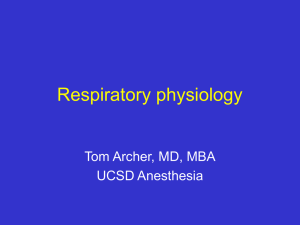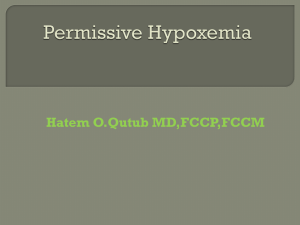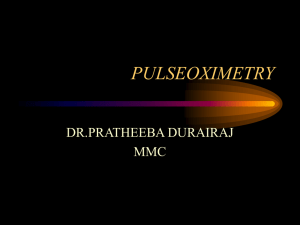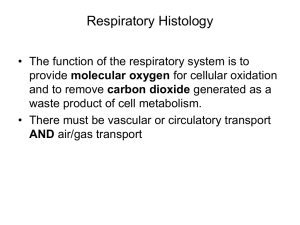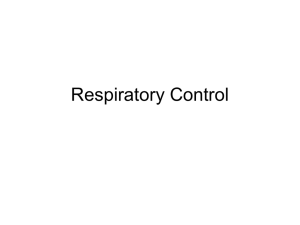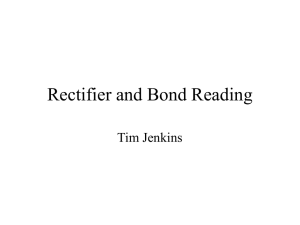Low V/Q 100% O2 allows saturation of hemoglobin in low V/Q alveoli.
advertisement
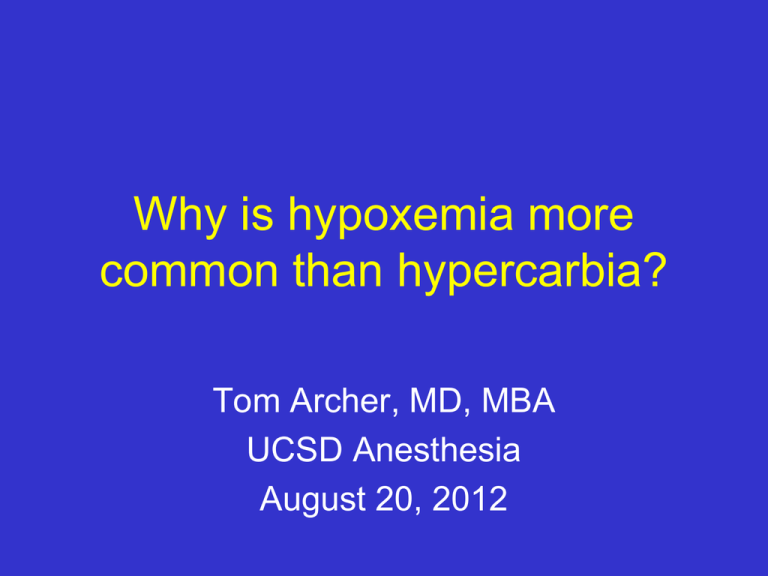
Why is hypoxemia more common than hypercarbia? Tom Archer, MD, MBA UCSD Anesthesia August 20, 2012 www.argentou r.com/tangoi.ht ml The dance of pulmonary physiology— Blood and oxygen coming together. But sometimes the match between blood and oxygen isn’t perfect! http://www.bookmakersltd.com/art/edwards_art/3PrincessFrog.jpg Failures of gas exchange Shunt Low V/Q Alveolar dead space Diffusion barrier High V/Q Failures of gas exchange Shunt Low V/Q Alveolar dead space Diffusion barrier High V/Q Don’t cause hypoxemia. Do cause increased PaCO2 – ETCO2 gradient. Failures of gas exchange Cause hypoxemia. Cause increased “A-a gradient for oxygen.” Shunt Low V/Q Alveolar dead space Diffusion barrier High V/Q Alveolar dead space and high V/Q alveoli • “Wasted ventilation” • Does not cause hypoxemia • Hallmark is ETCO2 << PaCO2 • Alveolar gas without any CO2 dilutes expired alveolar gas which contains CO2, thereby decreasing (mixed) ETCO2. 40 ETCO2 = 40 mm Hg ETCO2 = 20 mm Hg With no alveolar dead space With 50% alveolar dead space 20 40 20 Alveolar dead space gas (with no CO2) dilutes other alveolar gas. 40 46 40 46 0 0 40 46 Alveolar dead space • In normal, non-pregnant adult, PaCO2ETCO2 = 3-5 mm Hg. • In normal pregnancy PaCO2 – ETCO2 < 3, because of increased blood volume and pulmonary perfusion. Shunt and low V/Q alveoli do cause hypoxemia Failures of gas exchange Cause hypoxemia. Cause increased “A-a gradient for oxygen.” Shunt Low V/Q Alveolar dead space Diffusion barrier High V/Q Hypoxemia • Always think of mechanical problems first: – Mainstem intubation – Partially plugged (blood, mucus) or kinked ETT. – Disconnect or other hypoventilation – Low FIO2 – Pneumothorax For hypoxemia: – Hand ventilate and feel the bag! – Examine the patient! – Look for JVD. – Do not Rx R mainstem intubation with albuterol! – Do not Rx narrowed ETT lumen with furosemide! – Consider FOB and / or suctioning ETT with NS. Hypoxemia from shunt or low V/Q alveoli: • Mainstem intubation / mucus plugs • External compression of lung causing atelectasis and shunt. – Obesity, Trendelenburg, ascites, surgical packs, pleural effusion • Parenchymal disease (V/Q mismatch and shunt) – Asthma, COPD, pulmonary edema, ARDS, pneumonia, – Tumor, fibrosis, cirrhosis Intra-cardiac RL shunts (ASD, VSD, PDA) Hypoxia occurs more easily than hypercarbia. Why? The strong alveolus (high V/Q) The weak alveolus (low V/Q). A key question: • Can the high V/Q alveolus make up for the low V/Q alveolus? • No, for O2. • Yes, for CO2. The low V/Q alveolus The high V/Q alveolus pO2 = 50 mm Hg pO2 = 130 mm Hg SaO2 = 80% SaO2 = 75% SaO2 = 100% SaO2 = 75% pO2 = 50 mm Hg pO2 = 40 mm Hg pO2 = 40 mm Hg pO2 = 130 mm Hg Can the high V/Q alveolus compensate for the low V/Q alveolus? Not for oxygen! The high V/Q alveolus can’t saturate hemoglobin more than 100%. SaO2 of equal admixture of high and low V/Q alveolar blood = 90%. PaO2 = 60. Low V/Q) alveolus SaO2 = 75% Normal alveolus SaO2 = 96% High V/Q alveolus SaO2 = 99% Equal admixture of blood from low and high V/Q alveoli has SaO2 = (75 + 99)/ 2 = 87%. http://www.biotech.um.edu.mt/home_pages/chris/Respiration/oxygen4.htm Modified by Archer TL 2007 The low V/Q alveolus pCO2 = 44 mm Hg The high V/Q alveolus pCO2 = 36 mm Hg pCO2 = 44 mm Hg pCO2 = 46 mm Hg pCO2 = 36 mm Hg pCO2 = 46 mm Hg Can the high V/Q alveolus compensate for the low V/Q alveolus? Yes, for CO2! The high V/Q alveolus can blow off extra CO2. PaCO2 = 40 mm Hg Hypoxemia is more common than hypercarbia • High V/Q alveoli compensate for low V/Q alveoli for CO2– but cannot compensate with respect to O2! • Hence, when there is V/Q mismatch, hypoxemia will occur long before hypercarbia occurs. He3 MR showing ventilation defects in a normal subject and in increasingly severe asthmatics. Author Samee, S ; Altes T ; Powers P ; de Lange EE ; Knight-Scott J ; Rakes G Title Imaging the lungs in asthmatic patients by using hyperpolarized helium-3 magnetic resonance: assessment of response to methacholine and exercise challenge Journal Title Journal of Allergy & Clinical Immunology Volume 111 Issue 6 Date 2003 Pages: 1205-11 Baseline Methacholine Albuterol He3 MR scans – methacholine produces ventilation defects, corrected by albuterol. Modified by Archer TL 2007 100% O2 corrects hypoxemia due to low V/Q. 100% O2 does not correct hypoxemia due to shunt. Normal gas exchange, V/Q = 1, FIO2 = 0.21 Inspired PO2 = 140 mm Hg PAO2 = 100 mm Hg Sat % = 97% Sat % = 75% FIO2 = 0.21 does not allow saturation of hemoglobin in low V/Q alveoli. Inspired PO2 = 140 mm Hg Low V/Q PAO2 = 50 mm Hg Saturation = 80% Saturation = 75% 100% O2 allows saturation of hemoglobin in low V/Q alveoli. Inspired PO2 = 600 mm Hg Low V/Q PAO2 = 100 mm Hg Sat % = 97% Sat % = 75% 100% O2 will not correct hypoxemia due to shunt. Shunt prevents saturation of hemoglobin regardless of inspired FIO2. Inspired PO2 = 600 mm Hg Shunt, V/Q = 0 PAO2 = 40 mm Hg Saturation = 75% Saturation = 75% The End
